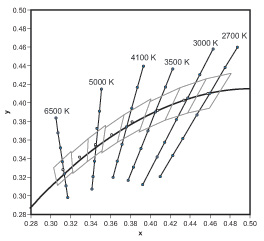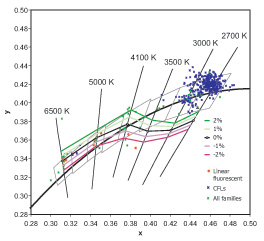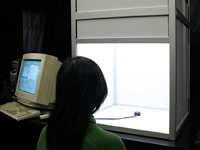ASSIST: Alliance for Solid-State Illumination Systems and Technologies

Chromaticities of the experimental SPDs (filled circles) for each CCT used. Also shown for reference are the ANSI tolerance quadrangles for solid-state light source and the center of each zone (open circles).

Iso-contours of 0% (i.e., white), ±1% and ±2% constant source tint for hue-magnitude judgments immediately upon seeing the illuminated box. Positive values are used to indicate green tint whereas negative values indicate purple tint. Similar results contours were found for judgments after 45 seconds and hue-choice judgments. |
Perceptions of White Light Sources of Different Color Temperatures
Light sources used for illumination have a “white”
appearance with chromaticities close to the
blackbody locus. Those with high CCT are
informally called “cool white” and those with low CCT are called “warm white.” surprisingly little research has been conducted, however, into the appearance of the light generated by “white” light sources used for illumination. To understand what constitutes perceptions of white lighting, the LRC conducted a series of experiments to measure perceptions of white illumination from light sources of different CCTs.
Experiment
Twenty subjects viewed a matte-white tabletop cube with an interior that was indirectly illuminated to 300 lx by combinations of eight independently controlled light sources. The matte-white hemisphere in the ceiling compartment mixed the light to create six groups of seven spectral power distributions (SPDs). All seven SPDs within a group had the same CCT: 2700 K, 3000 K, 3500 K, 4100 K, 5000 K, and 6500 K. Within each CCT group, one SPD had a chromaticity on the blackbody locus; the other six SPDs included the range of practical light sources sold as white illumination.
For each condition (i.e., one SPD from the selected CCT group), subjects were asked to immediately judge whether the light reflected off the interior walls was purple or green (hue choice) and what percentage of that hue was present (hue magnitude). Then subjects made the same judgments after 45 seconds.
Results
Generally, perceptions of untinted white illumination for sources with high CCTs (above 4000 K) are associated with chromaticities that fall above the blackbody locus. In contrast, perceptions of untinted white illumination for sources with low CCTs (below 4000 K) are associated with chromaticities that lie well below the blackbody locus.
The data show that every CCT (between 2700 K and 6500 K) has one or more chromaticities that are perceived as untinted white, as well as chromaticities showing different degrees of purple or green tint. The terms “warm” and “cool” also can be applied to every CCT, and that these terms are not homologous with CCT designation. Further, change in CCT along the blackbody is not a dimension of whiteness. Thus, this study can serve as a basis for future deliberations on target chromaticities for untinted white illumination, as well as for describing the source tints associated with currently manufactured lamps.

A subject views the experimental setup. |
Technical Reports & Publications
Rea, M.S. and J.P. Freyssinier. White lighting for residential applications. In press with Lighting Research and Technology, published online before print, March 27, 2012.
Rea, M.S. and J.P. Freyssinier. White lighting. In press with Color Research and Application. Article first published online November 28, 2011; DOI: 10.1002/col.20738.
Freyssinier, J.P., and M.S. Rea. Class A lighting. Presentation given at Strategies in Light 2012, February 7-9, Santa Clara, CA. 
Project Summary Sheet (2011)
Related Research
Understanding White Light Source Color Rendering and Appearance
Media Coverage
Wright, M. 2012. SSL must still clear hurdles to enable mass adoption of LED lighting. LEDs Magazine March 2012: 39-48.
Sponsor
ASSIST
|


